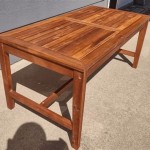Best Stain for Wood Patio Furniture
Protecting outdoor wood furniture from the elements is crucial for its longevity and aesthetic appeal. Choosing the right stain not only enhances the wood's natural beauty but also provides a protective barrier against sun, rain, and temperature fluctuations. This article explores various wood stain options, highlighting their strengths and weaknesses to help consumers make informed decisions.
Key Considerations When Choosing a Stain
Selecting a stain involves considering various factors, including the type of wood, desired finish, and level of protection needed. Understanding these elements will guide the selection process and ensure optimal results.
- Type of Wood: Different wood species react differently to stains. Softer woods like pine absorb more stain than hardwoods like cedar or teak.
- Desired Finish: Stains come in various opacities, from transparent to solid. Transparent stains showcase the wood grain, while solid stains completely cover it.
- Level of Protection: Consider the furniture's exposure to the elements. Furniture in direct sunlight and harsh weather will require a more durable stain.
- Application Method: Stains can be applied by brush, roller, or sprayer. Choose a method suitable for the project size and complexity.
- VOC Content: Volatile organic compounds (VOCs) contribute to air pollution. Look for low-VOC or zero-VOC options for a more environmentally friendly choice.
- Drying Time: Drying times vary between stains. Factor this into the project timeline to avoid delays.
- Maintenance Requirements: Some stains require periodic reapplication for continued protection.
Types of Wood Stains
Various stain types cater to different needs and preferences. Understanding their characteristics will help determine the best option for specific projects.
- Oil-Based Stains: These stains penetrate deeply into the wood, providing excellent protection and a rich, warm finish. They require longer drying times but offer superior durability.
- Water-Based Stains: These stains are easier to clean up and have lower VOCs. They dry faster than oil-based stains but may not penetrate as deeply.
- Gel Stains: These thicker stains are ideal for vertical surfaces and intricate designs, as they are less likely to drip. They provide good color and protection.
- Exterior Wood Stain and Sealer Combinations: These products offer the convenience of stain and sealant in one application, saving time and effort.
Protecting Against UV Damage
Sunlight can cause fading and discoloration of wood furniture. Choosing a stain with UV protection is essential for maintaining its appearance.
- UV Inhibitors: Look for stains containing UV inhibitors or absorbers to prevent fading and sun damage.
- Pigmented Stains: Stains with higher pigment concentrations offer better UV protection than transparent stains.
- Regular Reapplication: Even with UV protection, periodic reapplication of stain will help maintain the furniture's color and protect it from the sun's harmful rays.
Preparing the Wood for Staining
Proper preparation is crucial for achieving a smooth, even stain finish. Following these steps will ensure optimal results.
- Cleaning: Thoroughly clean the furniture with a wood cleaner or a mild detergent solution to remove dirt, grime, and mildew.
- Sanding: Sanding the wood creates a smooth surface for better stain penetration and adhesion.
- Removing Old Stain: If the furniture has previously been stained, the old stain may need to be removed with a stain stripper or by sanding.
Applying the Stain
Proper application techniques are essential for achieving a professional-looking finish.
- Testing the Stain: Test the stain on an inconspicuous area of the furniture to ensure the color and finish are as desired.
- Applying Even Coats: Apply thin, even coats of stain, following the wood grain.
- Wiping Excess Stain: Wipe off excess stain with a clean cloth to prevent blotching and unevenness.
- Drying Time: Allow ample drying time between coats and before using the furniture.
Maintaining Stained Wood Furniture
Regular maintenance will prolong the life of stained wood furniture and keep it looking its best.
- Cleaning: Regularly clean the furniture with a mild soap and water solution.
- Reapplying Stain: Reapply stain as needed to maintain the color and protection.
- Covering During Inclement Weather: Covering the furniture during periods of rain or snow will further protect it from the elements.
Choosing the Right Stain for Your Project
Selecting the appropriate stain depends on various factors. By considering the type of wood, desired finish, and level of protection required, one can make an informed decision and achieve beautiful, long-lasting results.

The Best Type Of Exterior Wood Stain For Your Ottawa Deck Bonds Decor

Exterior Wood Stain Buying Guide The Home

How To Restore Wooden Outdoor Furniture The Honeycomb Home

How To Refinish Outdoor Wood Furniture In Easy Steps

The Best Deck Stains Reviews Pricing Pro Tool

4 Deck Stain Colors For White Or Beige Houses All Your Wood Staining Questions Answered Olympic

What Wood Stain Should You Use In A Garden

When And How Often To Treat Outdoor Wood Finishes Direct

Exterior Wood Stain Buying Guide The Home

How To Refinish Outdoor Furniture The Craftsman Blog
See Also








